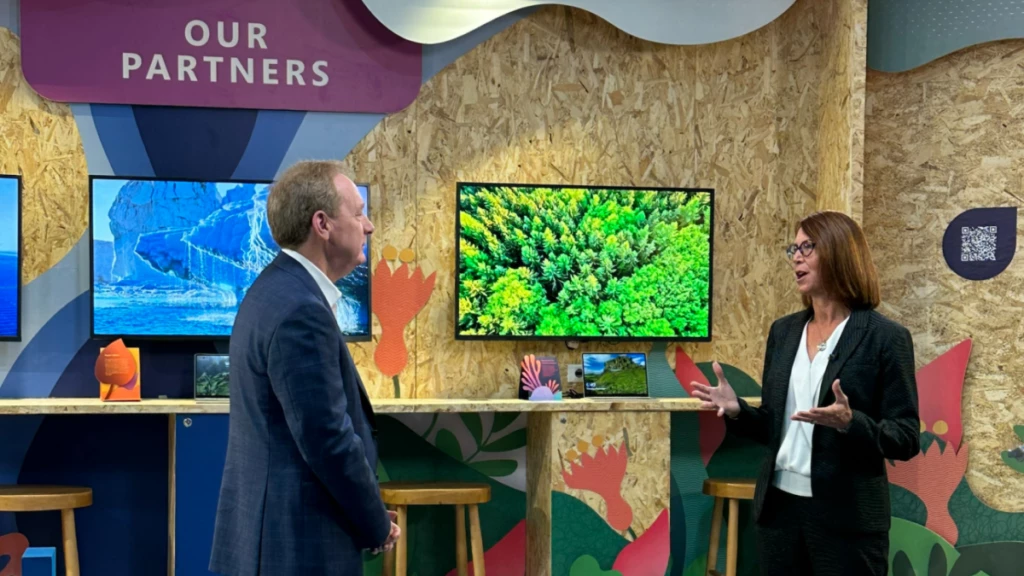
Reflecting on COP27: Sustainability meets commercial progress
With this year’s twenty-seventh United Nations Climate Change Conference of the Parties (COP27) in Sharm El Sheikh behind us, global decision-makers are reflecting on the many new perspectives and connections gained. I’m excited to tell you about my own experience and what I saw most: collective momentum toward decarbonization and resilience.
Microsoft participated as a strategic technology partner and principal sponsor with decades of experience working on our own sustainability and hopes of igniting new partnerships to drive progress. We met with dozens of organizations, many of them already closely linked with Microsoft and others just getting to know us—from chief sustainability officers (CSOs) to technology integrators and developers. We spoke to groups, participated in roundtable discussions, and were inspired by growing interest in Microsoft Cloud for Sustainability solutions like Microsoft Sustainability Manager.
Microsoft Cloud for Sustainability
Amplify progress and transform your business through growing environmental, social, and governance (ESG) capabilities.

We left COP27 with a feeling of optimism that will be key for forging our collective path forward. I talked with PwC Global Climate Leader Emma Cox about the solution mindset needed to embrace innovation not only as the basis for understanding impacts, including more elusive Scope 3 impacts, but as an opportunity for differentiation.
Key themes around momentum
COP27 was billed as the “implementation COP,” firmly centered on making the promises of Glasgow and previous climate conferences a reality. Focus areas for negotiations and on-the-ground discussions included:
- Driving real reductions across the global economy with a focus on transformation in hard-to-abate sectors like energy and transport.
- Continuing to drive energy efficiency and electrification amid the war in Ukraine and energy access issues in much of Africa.
- Increasing focus on ecosystem adaptation and resilience alongside reductions.
- Improving and expanding capital that’s deployed to accelerate progress.
These themes flowed into all our conversations, affirming a shared commitment to meaningful engagement among Microsoft and our customers and partners across sectors, who are similarly evolving and leading the way. These organizations have moved past the days of “Let’s get started” to “Let’s partner deeply and holistically to become more sustainable while maintaining growth.”
How we’re responding with solutions
Microsoft is serious about delivering solutions to address each challenge and opportunity area that came up. Here’s how we’re planning on doing it.
Expanding Scope 3 reporting capabilities in Microsoft Cloud for Sustainability. To help our customers respond to mounting pressures to report Scope 3 emissions and show real reductions, we’re continually working on improving access to quality data from across value chains. For example, we know that many European Union organizations must meet audit readiness requirements within the Corporate Sustainability Reporting Directive (CSRD), which was approved during COP27. These requirements include all Scope 3 emissions categories as well as social and governance requirements within a broader environmental, social, and governance (ESG) framework. To this end, we’re actively engaging our teams and global advisory partners in co-engineering expansion of Microsoft Cloud for Sustainability solutions like Microsoft Sustainability Manager and Emissions Impact Dashboard to further extend Scope 3 reporting and transparency.
Engaging more deeply with supply chain data, solutions, and business intelligence from partners to create new opportunities. At COP27, we heard from major food and beverage organizations about the need to drive regenerative agriculture practices into their supply chains and prove the reductions. We heard from automotive, mobility, and transportation (AMT) and manufacturing organizations that are working to source and produce lower-carbon materials with their suppliers. And we heard from financial services organizations that are attempting to diversify their lending practices without taking on undue risk to reduce their financed emissions. Many echoed a similar position of moving from ESG assessment to action, forming strategies to leverage emerging technologies like AI and machine learning to help meet Scope 3 demands.
I want to emphasize that with the continual development of Microsoft Cloud for Sustainability Scope 3 data tracking capabilities and use cases, these demands also represent opportunities. Sustainability reporting can be an all-up business intelligence activity—driving value chain reductions while also helping to solve complex business problems and prompting the creation of new solutions and services.
Creating new value through products, offerings, and value chains. To grow sustainably and cost-effectively, organizations need forward-leaning, predictive tools that show performance alongside changes in investment strategies and the realities of climate change and the global economy. They also need business intelligence that informs them on how to generate and sustain ROI for new services and bring those services to market.
Watch a discussion I had with Georgie Frost of Boston Consulting Group on the ways that digital technologies will factor into thriving—from understanding baseline impacts to how we can lean in, experiment, and act.
Increasingly, organizations are focusing beyond carbon, looking to make themselves more resilient while developing new pathways for their customers in a low-carbon economy. For example, in the beverage industry, companies are working on sustainable water sourcing with consideration for climate risk and water stress. New technology solutions can predict impacts on biodiversity and access to natural ingredients while enabling problem-solving around impacts on people and communities.
Microsoft is helping by prioritizing co-investment and co-innovation. We’re aligning our efforts with common and pressing customer pain points and leaning heavily on industry partners to better understand and build pathways to decarbonization and transformation.
For example, with TerraPraxis and Schneider Electric, we’re helping to develop and implement their EVALUATE app. This new technology will enable coal plants everywhere to evaluate facilities for conversion to clean energy. Using industrial software, innovative energy management, AI and automation systems, and Microsoft Cloud technologies, we’re working to repower coal-fired plants and enable them to continue operations emissions-free. This can save thousands of jobs and enable the reuse of existing infrastructure worldwide.
Adaptation, resilience, and the journey forward
COP27 showed a clear path forward that applies to all organizations and countries. The path will involve charting new strategies for adaptation and resilience; moving capital to enable rapid transformation where it’s most needed, especially in less developed nations and among those disproportionately affected, including women; and because we’ve learned that all industries are experiencing some common challenges and growth opportunities, it may involve developing more scalable cross-industry solutions for repeatable scenarios, lending to faster implementation.
As an established technology partner with deep experience in sustainability backed by decades of action and focused co-innovation, Microsoft is more committed than ever to helping customers and partners who join us on the path. Microsoft Cloud for Sustainability capabilities—helping to manage organizations’ environmental footprint, embed sustainability through organizations and value chains, and make strategic business investments that drive value—provide one substantial measure of progress. I’m energized by the conversations in Sharm El Sheikh and look forward to continuing the delivery of robust capabilities and partnerships.




